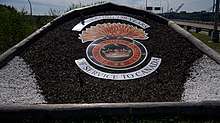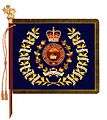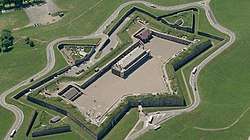The Princess Louise Fusiliers
The Princess Louise Fusiliers is a Primary Reserve light infantry regiment of the Canadian Forces.
| The Princess Louise Fusiliers (PLF) | |
|---|---|
| Active | 1867 - Present |
| Country | |
| Branch | |
| Type | Primary Reserve |
| Role | Light Infantry |
| Size | Battalion |
| Garrison/HQ | Halifax Armoury |
| Motto(s) | Fideliter (Faithfully) |
| Colours | Green, Gold, Burgundy |
| March | The British Grenadiers |
| Commanders | |
| Colonel-in-Chief | The Duke of York |
| Colonel of the Regiment | Col J.W. Miller, Honorary Colonel |
| Insignia | |
| Hackle | Grey |
History
Based in Halifax, Nova Scotia, this infantry regiment traces its local roots as a Halifax unit of Militia back to June 18, 1749, when Sir Edward Cornwallis formed a local Militia under his own command during Father Le Loutre's War. Ten companies were formed at the Grand Parade in the city and were made a collective battalion.
As an officially constituted unit of Canada, The Princess Louise Fusiliers were authorized in 1867. During the unit's history, it has undergone several name changes. On November 5, 1869, the regiment was named the 66th The Halifax Battalion of Infantry. Originally consisting of six companies, it later gained two more.
Ten years later, on November 14, 1879, the regiment was once again renamed, this time to the 66th Battalion "Princess Louise" Fusiliers, named for Princess Louise, daughter of Queen Victoria and wife of the Marquess of Lorne, Governor General of Canada at the time. It was shortly after this point in which the regiment received its first battle honour, when they helped suppress the Northwest Rebellion of 1885. Soldiers of the unit served in North West Canada with the Halifax Provisional Battalion. Fourteen years later, in 1899, the regiment provided some of its soldiers to a company raised in Nova Scotia for the 2nd (Special Service) Battalion of The Royal Canadian Regiment, which was raised for service in South Africa during the Second Boer War. May 8, 1900 brought about another name change, this time to 66th Regiment "Princess Louise" Fusiliers, and in October 1901 the regiment received new colours from the Duke of Cornwall and York (later King George V) during his visit to Canada. The new colours were subscribed for by the ladies of Halifax in honour of their battalion.[1]
During the First World War the 66th Regiment provided soldiers to the locally raised battalions of the Canadian Expeditionary Force (CEF). At the end of the war, as a result of the Otter Commission headed by General William Otter, the regiment perpetuated the 64th Canadian Infantry Battalion of the CEF. As a result of the unit's contributions of soldiers and this perpetuation, the regiment holds five battle honours of the First World War. In May 1915 the regiment was renamed to its current name, the Princess Louise Fusiliers.
The onset of World War II saw more action for the Fusiliers, when they were sent to Italy as part of the 5th Canadian Armoured Division. The regiment fielded two machine gun companies, the 11th Independent MG Coy. in support of the 11th Infantry Brigade, and the 12th Independent MG Coy. in support of the 12th Infantry Brigade. In British and Commonwealth armoured divisions of that period, independent MG coys. consisted of a HQ platoon, plus one platoon operating Browning .50 cal. heavy MGs and a second platoon operating 107mm heavy mortars; they were heavy direct-fire support units.
In February 1945 the 5th Armoured was transferred from Italy to Belgium, and these two companies participated in the liberation of the Netherlands from late March to the German surrender. During the conflict, the regiment received nine more battle honours, bringing their total count to 16.
Following World War II, the PLF converted back to a light infantry unit. Their most recent battle honour, received in 1999 following a lengthy struggle by unit officers to discover the necessary supporting documents, was for the unit's actions at Arnhem in 1945.
In Afghanistan, on Easter Sunday, April 8, 2007, Master Corporal Chris Stannix was killed along with five other Canadian soldiers when their vehicle was hit by an explosive device. Corporal Shaun Fevens was injured in the explosion and transported to a military hospital in Germany.
The PLF performed a ceremonial Trooping the Colours at Citadel Hill in Halifax Nova Scotia on 23 April 2009. Inspecting the parade was His Royal Highness Duke of York Prince Andrew, The Colonel in Chief of the Princess Louise Fusiliers, with a large crowd in attendance.
On May 14, 2014, a new passenger transit harbour ferry was christened the "Christopher Stannix" as it was brought into service as part of the Halifax Metro Transit Ferry System. The Christopher Stannix ferry is the first of five new ferries introduced to modernize the current fleet. The ceremony in honour of the naming of the ferry in the memory of Master Corporal Stannix was well attended by the public as well as members of the Stannix family, the CO, RSM, and a number of serving and former-serving members of the regiment.
In celebration of the 150th anniversary of the formation of the regiment, the city of Halifax installed two special displays in its honor. The first was a recreation of the regiment's flaming grenade hat badge in the form of a floral display, prominently displayed in the Public Gardens. A second was installed on the Halifax side of the A. Murray McKay bridge, this time displaying a large version of the famous hat badge, framed in a bed of stones and commemorating 150 year of service to Canada.
In June 2019, the regiment celebrated its 150th anniversary with a Freedom of the City parade, with the regiment parading through the city in their distinct scarlet uniforms. Former members of the regiment were also present on parade as a formed contingent of "The Old Guard".
The unit ranks 2nd in Atlantic Reserve Units behind none other than the infamous Nova Scotia Highlanders.

Battle Honours
The Princess Louise Fusiliers have been awarded 17 battle honours since the unit's inception in 1869. (See listing below)
(Emblazoned=Yes indicates that the battle honour has been emblazoned on the Regimental Colour)
| Battle Honour | Conflict | Dates | Emblazoned |
|---|---|---|---|
| NORTH-WEST CANADA, 1885 | North West Rebellion | 1885 | Yes |
| SOUTH AFRICA, 1899-1900 | South African War | 1899-1900 | Yes |
| SOMME, 1916 | World War I | 1 JUL–18 NOV 1916 | Yes |
| ARRAS, 1917 | World War I | 9 APR–4 MAY 1917 | Yes |
| Ypres, 1917 | World War I | 31 JUL–10 NOV 1917 | No |
| AMIENS | World War I | 8-11 AUG 1918 | Yes |
| Hill 70 | World War I | 15-25 AUG 1917 | No |
| LIRI VALLEY | World War II | 18-30 MAY 1944 | Yes |
| MELFA CROSSING | World War II | 24-25 MAY 1944 | Yes |
| GOTHIC LINE | World War II | 25 AUG-22 SEP 1944 | Yes |
| CORIANO | World War II | 3-15 SEP 1944 | Yes |
| LAMONE CROSSING | World War II | 2-13 DEC 1944 | Yes |
| MISANO RIDGE | World War II | 3-5 SEP 1944 | Yes |
| ITALY, 1944-1945 | World War II | 1944-1945 | Yes |
| DELFZIJL POCKET | World War II | 23 APR–2 MAY 1945 | Yes |
| NORTH-WEST EUROPE, 1945 | World War II | 1945 | Yes |
| Arnhem 1945 | World War II | 12-14 APR 1945 | Approved |
 Regimental Colour of the Princess Louise Fusiliers
Regimental Colour of the Princess Louise Fusiliers Camp Flag of the Princess Louise Fusiliers
Camp Flag of the Princess Louise Fusiliers
Theatre Honours
On May 9, 2014 it was announced that the Princess Louise Fusiliers would be among the units to be awarded the “Afghanistan” Theatre Honour to recognize the dedication and sacrifice made by members of the unit who took part in Canada’s operations in Afghanistan, the longest armed conflict in Canadian history.
Theatre Honours are a type of Battle Honour given to publicly recognize a Canadian Armed Forces unit for successful participation in a theatre of armed conflict. Such honours have been awarded after every major conflict in which Canada has been engaged.
Alliances

Hackle
As a fusilier regiment, the PLF wear a hackle. In the case of the PLF it is the grey hackle of the Royal Inniskilling Fusiliers. (Affiliated regiment)
Armoury
| Site | Date(s) | Designated | Location | Description | Image |
|---|---|---|---|---|---|
| Halifax Armoury 2667 North Park Street, | 1895-99 (completed) | National Historic Sites of Canada; Classified - 1991 Register of the Government of Canada Heritage Buildings | North Central Halifax Regional Municipality |
|
|
Media
- From Farm Boy to Soldier: Experiences of a World War II Vetern Princess Louise Fusiliers by Gordon P. Hogan (2005)
See also
- The Canadian Crown and the Canadian Forces
- Military history of Nova Scotia
- List of armouries in Canada
- Military history of Canada
- History of the Canadian Army
- Canadian Forces
References
- "The Royal tour". The Times (36591). London. 21 October 1901. p. 3.
| Wikimedia Commons has media related to The Princess Louise Fusiliers. |
External links
Order of precedence
| Preceded by Les Fusiliers Mont-Royal |
The Princess Louise Fusiliers | Succeeded by The Royal New Brunswick Regiment |
